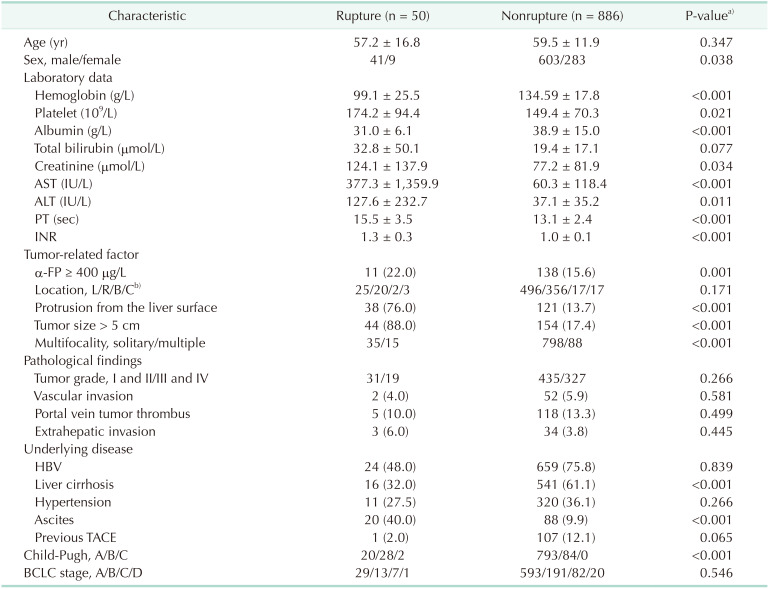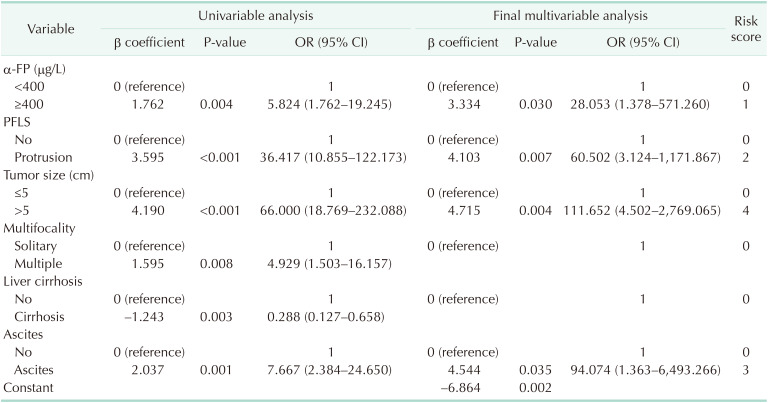1. Zhu Q, Qiao G, Xu C, Yu X, Zhao J, Yu Z, et al. Conditional survival in patients with spontaneous tumor rupture of hepatocellular carcinoma after partial hepatectomy: a propensity score matching analysis. HPB (Oxford). 2019; 21:722–730. PMID:
30389432.
2. Sahu SK, Chawla YK, Dhiman RK, Singh V, Duseja A, Taneja S, et al. Rupture of hepatocellular carcinoma: a review of literature. J Clin Exp Hepatol. 2019; 9:245–256. PMID:
31024207.
3. Jeng KS, Huang CC, Lin CC, Lin CK, Teng CJ, Chen KH. Liver transplantation after downstagings of ruptured advanced hepatocellular carcinoma in cirrhotic liver: is it advisable? A case report. Transplant Proc. 2019; 51:1468–1471. PMID:
31056250.
4. Moris D, Chakedis J, Sun SH, Spolverato G, Tsilimigras DI, Ntanasis-Stathopoulos I, et al. Management, outcomes, and prognostic factors of ruptured hepatocellular carcinoma: a systematic review. J Surg Oncol. 2018; 117:341–353. PMID:
29116644.
5. Pillai A, Couri T, Charlton M. Liver allocation policies in the USA: past, present, and the future. Dig Dis Sci. 2019; 64:985–992. PMID:
30895482.
6. Kerdsuknirun J, Vilaichone V, Vilaichone RK. Risk factors and prognosis of spontaneously ruptured hepatocellular carcinoma in Thailand. Asian Pac J Cancer Prev. 2018; 19:3629–3634. PMID:
30583692.
7. Li J, Huang L, Liu CF, Cao J, Yan JJ, Xu F, et al. Risk factors and surgical outcomes for spontaneous rupture of BCLC stages A and B hepatocellular carcinoma: a casecontrol study. World J Gastroenterol. 2014; 20:9121–9127. PMID:
25083085.
8. Cook NR. Use and misuse of the receiver operating characteristic curve in risk prediction. Circulation. 2007; 115:928–935. PMID:
17309939.
9. Justice AC, Covinsky KE, Berlin JA. Assessing the general izabi l it y of prognostic information. Ann Intern Med. 1999; 130:515–524. PMID:
10075620.
10. Daskivich T, Luu M, Noah B, Fuller G, Anger J, Spiegel B. Differences in online consumer ratings of health care providers across medical, surgical, and allied health specialties: observational study of 212,933 providers. J Med Internet Res. 2018; 20:e176. PMID:
29743150.
11. Kang L, Liu A, Tian L. Linear combination methods to improve diagnostic/prognostic accuracy on future observations. Stat Methods Med Res. 2016; 25:1359–1380. PMID:
23592714.
12. Chua DW, Koh YX, Allen JC, Chan CY, Lee SY, Cheow PC, et al. Impact of spontaneous rupture on the survival outcomes after liver resection for hepatocellular carcinoma: a propensity matched analysis comparing ruptured versus non-ruptured tumors. Eur J Surg Oncol. 2019; 45:1652–1659. PMID:
31003720.
13. Zheng J, Chou JF, Gönen M, Vachharajani N, Chapman WC, Majella Doyle MB, et al. Prediction of hepatocellular carcinoma recurrence beyond Milan criteria after resection: validation of a clinical risk score in an international cohort. Ann Surg. 2017; 266:693–701. PMID:
28650354.
14. Ren A, Luo S, Ji L, Yi X, Liang J, Wang J, et al. Peritoneal metastasis after emergency hepatectomy and delayed hepatectomy for spontaneous rupture of hepatocellular carcinoma. Asian J Surg. 2019; 42:464–469. PMID:
30420157.
15. Zhu Q, Li J, Yan JJ, Huang L, Wu MC, Yan YQ. Predictors and clinical outcomes for spontaneous rupture of hepatocellular carcinoma. World J Gastroenterol. 2012; 18:7302–7307. PMID:
23326137.
16. Aoki T, Kokudo N, Matsuyama Y, Izumi N, Ichida T, Kudo M, et al. Prognostic impact of spontaneous tumor rupture in patients with hepatocellular carcinoma: an analysis of 1160 cases from a nationwide survey. Ann Surg. 2014; 259:532–542. PMID:
23478524.
17. Liu C, Xiao GQ, Yan LN, Li B, Jiang L, Wen TF, et al. Value of α-fetoprotein in association with clinicopathological features of hepatocellular carcinoma. World J Gastroenterol. 2013; 19:1811–1819. PMID:
23555170.
18. Zhu L, Geng X, Fan S. Vascular elasticity in patients with spontaneous rupture of hepatocellular carcinoma. Zhonghua Gan Zang Bing Za Zhi. 2002; 10:96. PMID:
11983121.
19. Wu J, Tong RL, Ding CF, Zhou J, Xu XF, Wang WL, et al. Establishment of prediction model for spontaneous rupture of primary liver cancer. Zhejiang Da Xue Xue Bao Yi Xue Ban. 2014; 43:652–657. PMID:
25644563.
20. Chernyak V, Santillan CS, Papadatos D, Sirlin CB. LI-RADS® algorithm: CT and MRI. Abdom Radiol (NY). 2018; 43:111–126. PMID:
28695233.






 PDF
PDF Citation
Citation Print
Print





 XML Download
XML Download